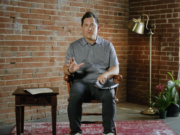
This week has been crazy. The Q&A series got off to a strong start and I’ve had to do some rethinking and strategizing about the series after last Sunday. I’ve learned sometimes you can repair a plane while it is still flying, but other times you just need to return to the hanger and fix the plane on solid ground. I’ve spent a few days in the hanger and this is what I learned as it relates to preaching a Q&A sermon series (at least for me):
First, a few fundamentals had to be changed. As I started this series, I had no idea what to expect. Would people actually text in? Would it feel authentic if I took my prep with me to the pulpit? What would the stage set look like? Would I stand or sit? And on and on the questions go. Truth be told, I probably over analyzed this series. But I’ve never been challenged like this before; To prepare for a sermon that you don’t know where it will go is a lot harder then preparing a sermon from a text that you know exactly where it is headed. So here are a few things I needed to change:
- I need to be more prepared, but less scripted. Last week I spent about 12 hours preparing for the sermon before writing the outline (I wish it had been more). I read all my old Bibliology notes, Grudem’s Systematic Theology, MacDonald’s “God Wrote a Book” and many other resources off my shelf. I was prepping a lot of content, but it was not until Saturday morning that I figured out the “Outline.” I wrote an outline that you can see on the sermon notes page, but it was far too scripted. So going forward, I will still prep a lot but not be as worried about the outline. The important part is that I have the key passages and points memorized in order to give a quick response.
- Q and A is random, so go with it. I like having a plan – especially when I am up in front of people. But sometimes the best way God moves is outside man’s plan. I need to trust that the Word of God will not return void and know that as the questions are placed on the screen, I just need to answer from God’s Word; no eloquent 3-point sermon required.
- Be myself. I preached the first part of the sermon as I normally do, walking around the stage. Then for the Q&A part, I sat down at a table with my Macbook Pro in front of me (more as a prop than anything). I need to make this more natural – I need to be me, as if I am sitting with a friend over coffee to answer some tough questions. so I will do more natural “me” things like have a cup of coffee on the table, get up and walk around when I get fired up, use my Mac to look up a passage or something I’ve written on the topic, and laugh more. I cant’ be staged, I must be me – this is the “Eothos” of preaching. One of the benefits of this series is that I am building a trust relationship with the people in the seats; if I want it to be an authentic relationship, then I need to be myself and not a squatting Bible guru.
Second, I needed to seek some advice from those who had gone before. I took some time this week to go read, listen, and watch people who have gone before me and answered hard questions. People such as Albert Mohler (in his blog and old radio show), Tim Keller, Mark Driscoll, Willie George, C.J. Maheney, John Piper, Matt Chandler and whomever else I could find that had answered questions in all sorts of different settings. I watched their technique. I studied their boldness. I witness God speaking through them.
I also watched a few comedians. Why? Because comedians are the best at transferring from one topic to the next without a hiccup. They can change topics seamlessly while keeping their audiences attention. This is important because I will be changing questions/topics every few minutes.
Third, my approach to the questions has to be all different. I had planned that we would cover six specific topics in this series – Bible, Suffering, Angels, Demons, Christian liberties, Sex. I still plan on addressing these topics, but they may not be the subjects for an entire Sunday sermon. Now I will take a more random approach each Sunday by addressing several questions on at least three different topics. The sermon will be broken up something like this: 1/3 answering questions from last week, 1/3 answering questions on the topic prescribed, and 1/3 on random and unrelated questions. This is only about 10 minutes for each of those topics with a five-minute intro and outro to make for a 40-minute sermon. I am taking a timer on stage with me this week.
Finally, the goal is more important than the means to getting there. The final lesson I’ve learned (at least in the first week of this) is that I can’t be worried about having all the answers in my head and looking wise and eloquent in my delivery. The bottom line is that the people want the answers. They don’t care if I have to reference someone else (in the sermon and in my articles on the web), or if I have to look it up on my Mac, or if I need to say, “I don’t know, but let me get back to you…” They just want answers. These are real people with real questions needing to hear from a real God. I am not that God… I am just His mouthpiece. This series has to be to about getting to the goal not about making the path pretty.
So here we go into week two of this series. If relevant, I will write more lessons learned in the future. My hope is that other pastors will see the need to answer questions boldly, without apology, publically, from God’s Word, on a regular basis.
Please pray for me.
Do you have any other thoughts or advice for me? I would gladly take it!







![Where is God when Discouragement Sets In? [Sermon]](https://joshweidmann.com/wp-content/uploads/2022/06/paola-chaaya-eAkjzXCU0p0-unsplash-180x135.jpg)

![How to Help Kids with Anxiety [video]](https://joshweidmann.com/wp-content/uploads/2020/07/mladen-borisov-RzbUUaP2JXY-unsplash-180x135.jpg)



